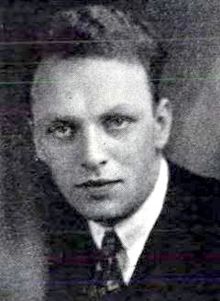Øystein Ore
Øystein Ore , German Öystein Ore, English Oystein or Oysten Ore, (born October 7, 1899 in Kristiania (now Oslo ), Norway ; † August 13, 1968 in Oslo) was a Norwegian mathematician who mainly dealt with the subjects of abstract algebra , Graph theory and number theory dealt with.
life and work
Ore went to school in Oslo (then still Kristiania) and began studying there in 1918 with Thoralf Skolem and in Göttingen with Emmy Noether (he also spent some time at the Mittag-Leffler Institute in Djursholm , Sweden). In 1924 he received his doctorate in Oslo with Thoralf Skolem on the theory of algebraic bodies . In 1925 he visited Göttingen again and the Sorbonne in Paris before becoming an assistant in Oslo in 1925. In 1927 he received an invitation to go to Yale University , where he became Associate in 1928 and Full Professor in 1929 and Sterling Professor in 1931 . He stayed at Yale until his retirement in 1968, and from 1936–1945 he was chairman of the faculty. Almost every year during this time he visited Oslo.
Ore worked first in group theory and in algebraic number theory , then in the theory of non-commutative rings. In the US, he worked with Garrett Birkhoff over lattice theory (Lattice Theory) and then he turned to graph theory, about which he wrote a number of books.
As part of his work, he first dealt with the so-called skew polynomials . In order to generalize the localization to non-commutative rings, he discovered the Ore conditions, which were later named after him . Ores name is also associated with one of the classic theorems of association theory , the so-called Kurosch-Ore theorem .
With Emmy Noether, he edited the collected works of Richard Dedekind . He is also known for his biographies of Niels Henrik Abel and Gerolamo Cardano . As a historian, he was also concerned with the history of probability theory, in particular the role of Blaise Pascal . He also wrote books on the four-color problem and the history of number theory.
For the support of his homeland during the Second World War (he organized aid programs) he was made Knight of St. Olaf by the Norwegian King in 1947. He was a member of the American Academy of Arts and Sciences (1966) and the Academy of Sciences in Oslo. In 1936 he gave a plenary lecture at the International Congress of Mathematicians in Oslo (The decomposition theorems of algebra).
He had been married to Gudrun Lundevall since 1930 and had two children with her.
His PhD students include Marshall Hall , Bruce Lee Rothschild, and Grace Hopper .
Fonts
- Number theory and its history. McGraw-Hill, New York NY et al. 1948.
- Cardano, the gambling scholar. With a translation from the Latin of Cardano's Book on games of chance by Sydney Henry Gould. Princeton University Press, Princeton NJ et al. 1953.
- Niels Henrik Abel. Mathematician extraordinary. University of Minnesota Press, Minneapolis MN et al. 1957.
- The theory of graphs (= American Mathematical Society. Colloquium Publications. 38, ISSN 0065-9258 ). American Mathematical Society, Providence RI 1962.
- Graphs and their uses (= New Mathematical Library. 10, ISSN 0548-5932 ). Random House, New York NY 1963.
- The four-color problem (= Pure and Applied Mathematics. A Series of Monographs and Textbooks. 27, ISSN 0079-8169 ). Academic Press, New York NY et al. 1967.
- Invitation to Number Theory (= New Mathematical Library. 20). The Mathematical Association of America, Washington DC 1967.
Web links
- Literature by and about Øystein Ore in the catalog of the German National Library
- John J. O'Connor, Edmund F. Robertson : Øystein Ore. In: MacTutor History of Mathematics archive .
- Øystein Ore in the Mathematics Genealogy Project (English)
- Biography about Øystein Ore on nbl.snl.no in Norsk biografisk leksikon (Norwegian)
- Øystein Ore on snl.no in the store norske leksikon (Norwegian)
| personal data | |
|---|---|
| SURNAME | Ore, Øystein |
| BRIEF DESCRIPTION | Norwegian mathematician |
| DATE OF BIRTH | October 7, 1899 |
| PLACE OF BIRTH | Oslo , Norway |
| DATE OF DEATH | August 13, 1968 |
| Place of death | Oslo , Norway |
